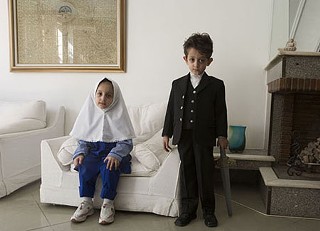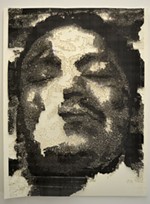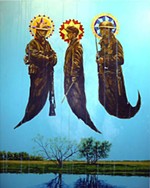‘2007 Texas Biennial, Butridge Gallery’
The Chronicle's visual-arts writers review the second Texas Biennial in dialogue and find the work at the Dougherty Arts Center to be diverse but presented awkwardly
Fri., March 30, 2007
2007 Texas Biennial, Butridge Gallery
Butridge Gallery, Dougherty Arts Center, through April 15
(Because of the significance and scope of the Texas Biennial, which is statewide in reach and spread across four Austin galleries, the Chronicle's visual-arts writers chose to review the exhibit collectively, in a dialogue. They will cover each gallery separately.)
Nikki Moore: I think this was a good second run for the Biennial, and the Dougherty Arts Center opening showed a fairly diverse range of work. Frances Bagley's Braided Rug was uncanny: a 644-foot braid of human hair that was truly at home and not at home all at once. I thought it was both provocative and generating: The piece makes you think about the human lives in and behind most of the materials we live among on a daily basis. And while I agree it was different somehow than the other work in the show, I have to say that I really liked Michael Velliquette's work; it was a tight group of compositions, and the colors were spectacular. I thought it worked well with Lily Hanson's textile sculpture and Andrew Anderson's techno-inspired color-fields.
Salvador Castillo: For me, Velliquette's paper works seemed a little out of place. The colors were brighter than most of the other works. Overall, the works at the DAC felt very concerned with formal elements. Maybe it was the lighting on opening night, but it felt a little cold. And the layout of the gallery disrupts the flow of the exhibition.
Amanda Douberley: I'm with Salvador on the gallery's disruptive layout. With maybe one or two exceptions, every piece at the DAC felt shoved into a corner. Worst of all was Michele Grinstead and Nancy O'Connor's Immigrant Memorial, which was probably a major cause of the big squeeze but ironically enough wasn't actually given adequate space. When I first saw this work, I admired the large color photographs; then I noticed the other components and had to read wall labels to piece it all together. I thought the big, black padlocked box was a little heavy-handed, but I admired the political statement; however, Immigrant Memorial felt out of place within the context of other works at the DAC. How would this piece have worked differently if placed a little closer to Kurt Mueller's Red Dawn?
NM: Initially, I was also taken with Soody Sharifi's Honeymoon. The contrast between the Speedo-clad body builder, pumped most likely with steroids (notice the acne), and the fully draped woman beside him raises so many questions. First, if I feel sorry for the woman in all her coverings, should I not also pity the man who seems obsessed with his own appearance? Are both not subject to body-conscious cultures, even if they seem to be cultures of polar extremes? Second, what sort of power play am I making as viewer and judge of this image? Isn't my act of looking at least as questionable and condescending as what I imagine is the Speedo man's view of his new veiled wife? That the photos are staged was somehow disappointing – but it doesn't change the nature or impact of the questions Sharifi's work raises.
I think each of these works hint toward "thinking as resistance" … opening up ways of thinking that go beyond the remixing of what we already know. I think they are part of a good start for a young exhibition.
SC: The fact that Soody Sharifi's photos are staged is irrelevant to me. I'm convinced of the old argument that all photos lie. I took in the image and interpreted what the artist is saying.
Forced to look at only one or two pieces by each artist makes it difficult to interpret the artist individually from the whole Biennial. I remember Velliquette because of his set of five. It was easier to see what overall concerns the artist is interested in. Everyone else's was a crapshoot and as easy to misinterpret as one-liners.
NM: Salvador, your point is well-taken: all photography, all art, lies. That is why layering, nuance, and experimentation are so important: They open potential space for something other than the status quo. It is hard to see an artist through one piece, as you say, but apart from dealing with the already pressing physical constraints that you and Amanda are noting in the DAC, would three pieces per artist be any more "revealing" … or would five? What is the magic number – where quantity translates to understanding? It's a tough call.









